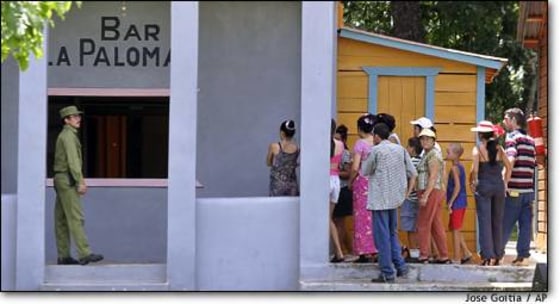It’s been a long time since anybody paved the potholed road to Fidel Castro’s birthplace. Finding the place isn’t easy either: No signs refer to it and the entry is little more than an unmarked dirt path. Still, some 20,000 people over the past year have made their way to the recently restored, little-publicized monument to the man who has led Cuba for the past 44 years and who on Saturday celebrates the 50th anniversary of the launch of his revolution.
“WE HAVE TO take care of it. This is a historic jewel,” said Alcides Leyva, director of the sprawling, rustic homestead at the heart of 32,100 acres that once belonged to Angel Castro, the Cuban leader’s father.
There’s the crib where the leader was born, the chair where he sat in a one-room school, the cockfighting arena where his father’s birds fought and the roadside saloon where his brother Raul, now defense minister and first vice president, briefly tended bar.
Angel Castro even built a movie theater. There was no church — and he planned none, Leyva said, though the bedroom of Fidel Castro’s mother, Lina Ruz, is adorned with portraits and statuettes of saints.
The Cuban leader has written of happy memories of his countryside childhood, but he has shown little attachment to the place itself.
It was the first farm expropriated as Castro’s government pushed into collectivized agriculture.
Leyva said Castro had even signed plans to flood the buildings under a reservoir in the 1960s before his secretary, Celia Sanchez, intervened to save it.
While Castro has rarely avoided the limelight, he has taken pride in avoiding the showy fawning by followers of the sort common in Saddam Hussein’s Iraq or North Korea.
“There is no cult of personality around any living revolutionary in the form of statues, official photographs or the names of streets or institutions,” Castro said in his May Day speech this year. “The leaders of this country are human beings, not gods.”
Castro hasn’t even visited Biran since the property was restored and quietly opened to the public in November 2002. Even the name of the place, “The Biran Historic Site,” makes no mention of Castro, who is among the most famous Latin American figures of the 20th century.
“The chief has always been very austere about this,” Leyva said, a bit sadly.
The wooden buildings are scattered between towering trees on a parklike spread of grass that is still marked by the trace of the old Camino Real — which was still the main road from Santiago to Cuba’s north coast when Fidel Castro was young.
IMPOVERISHED PAST
Castro’s father was born in a one-room stone house in Spain’s Galicia region and served in Cuba as a Spanish soldier from 1895 to 1898. He returned as an immigrant in 1902, according to the Biran site historian, Antonio Lopez.
InsertArt(1967382)At first an impoverished laborer, he began to organize contract labor for the U.S. United Fruit Company and started to buy land west of the Pinares de Mayare mountains.
Angel Castro was barely literate, but was wealthy enough to send his 10 children to some of Cuba’s best schools. Leyva said that an apartment on the property had been intended for Fidel, in hopes the son would return to help run the family businesses.
Instead, the young attorney turned to politics and then to revolution. When Angel Castro died of a fall at age 81 in 1956, his son was in Mexico, planning guerrilla war, after being freed from prison. He had been convicted of attacking the Moncada military barracks in Santiago to the east of here on July 26, 1953.
Fidel Castro spent only his early childhood living at the property before he was sent to boarding school in Santiago, though he often returned for vacations.
A reconstructed version of the balcony-lined family home — the original was destroyed in a fire — includes rooms lined with photos: Fidel at age 3, with a flower in his pocket; at age 7, wearing a sailor suit; shooting a basketball for the Belen school team in Havana in 1943; posing in a pith helmet with a dog and hunting rifle in Biran that same year.
In another room, a portrait of Castro as a young guerrilla was signed for his mother by Santiago’s Catholic archbishop: “God bless him.”
Leyva said that fervent Castro loyalists had been trying to visit — and had been turned away — for years before Castro agreed to lift the ban on visits.
“In spite of the fact that he did not want promotion, everybody knew where he had lived,” Leyva said.© 2003 Associated Press. All rights reserved. This material may not be published, broadcast, rewritten or redistributed.
